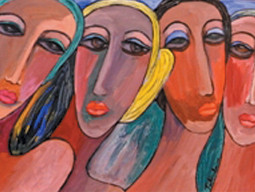
Last week, Musarrat Hasan’s book on five decades of Mian Ijazul Hasan’s painting was launched. Let us discuss his work in the context of some general ideas on the sense in which we use the word art, its nature and the relationship between art and politics.
Underlying the attempt to define art is the Platonic idea that the meaning of a word is what it names. Now, a set of objects — in this case, art objects — must have some common property that the common designation signifies. Benjamin Tilghman asks, what is that common property in the case of works of art, some latent essence? The linguistic problem of using the word art for a variety of different objects was solved by Ludwig Wittgenstein, the Cambridge linguistic philosopher. He suggested that the way a word functions in language can be understood by how the word is taught to children. We do not, for example, teach children the word “games” by defining it in terms of a set of criteria, but rather describe a game. After getting the description of a few examples of games or actually seeing them being played, the child learns to call other human interactions “games” because they are similar to the games whose descriptions were earlier heard or were seen being played. So it is with the word “art”. We learn to recognise a particular object as art not by grasping some non-existent latent essence, but because we discover strands of similarities with other works of art that we have come across.
While the word “art” can be understood in the sense of Wittgenstein, by the way it works in language, there is also the experiential dimension, the complex set of emotions and imagination that come into play upon seeing a work of art. It is thus that the artist affects other people. Adolpho Sanchez Vazquez suggests that art “contributes to the reaffirmation or devaluation of ideas, goals or values”. By influencing the way people think or feel about issues, art becomes a social force. At one level, the battle against the extremists is a battle of ideas. How else, except through ideology, can rational individuals be persuaded to don suicide jackets or, alternatively, embrace love and reject hate? Art can help in reclaiming our humanness in the ongoing battle of hearts and minds.
Mian Ijazul Hasan’s paintings draw us into the poignant transience of nature as much as human beings. Yet, there is also the intimation of significance of our being in this world. As the poet Rainer Maria Rilke says “Just once, everything, only for once … And we, too, once. And never again … But this having been once on earth — can it ever be cancelled?”
Hasan’s paintings enable us to simultaneously experience the sensuousness and transcendent beauty of nature counterposed with the brutality of an unjust society. We are invited to apprehend this polarised metaphor through an existential choice: to actualise the organic connection between our sense of beauty and our human nature by building a humane society.
Published in The Express Tribune, May 5th, 2013.
COMMENTS (1)
Comments are moderated and generally will be posted if they are on-topic and not abusive.
For more information, please see our Comments FAQ




























1714024018-0/ModiLara-(1)1714024018-0-270x192.webp)









The lessons the learned writer wishes to teach to the masses of this unfortunate country are not likely to home in. I wonder if this brilliant article can even be accurately translated into Urdu. It could, however, make a difference if the ideas could be conveyed through religion. But how does one introduce art to a person for whom even music, the only universal language is a taboo? Art is for only those with highly developed sensibilities; not for the masses, unfortunately.